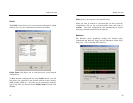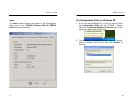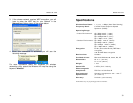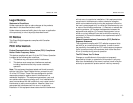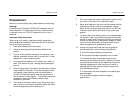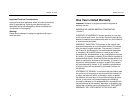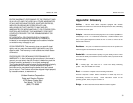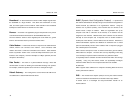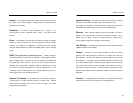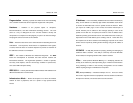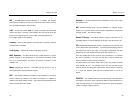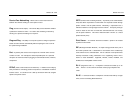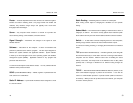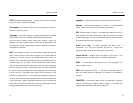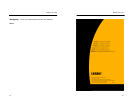
Wireless PC Card
41
Domain – A sub network comprised of a group of clients and servers under
the control of one security database. Dividing LANs into domains improves
performance and security.
Download – To receive a file transmitted over a network. In a
communications session, download means receive, and upload means
transmit.
Driver – A workstation or server software module that provides an interface
between a network interface card and the upper-layer protocol software
running in the computer; it is designed for a specific NIC, and is installed
during the initial installation of a network-compatible client or server operating
system.
DSSS (Direct-Sequence Spread-Spectrum) – DSSS generates a
redundant bit pattern for each bit to be transmitted. This bit pattern is called a
chip (or chipping code). The longer the chip, the greater the probability that
the original data can be recovered. Even if one or more bits in the chip are
damaged during transmission, statistical techniques embedded in the radio
can recover the original data without the need for retransmission. To an
unintended receiver, DSSS appears as low power wideband noise and is
rejected (ignored) by most narrowband receivers.
Dynamic IP Address – An IP address that is automatically assigned to
a client station in a TCP/IP network, typically by a DHCP server. Network
devices that serve multiple users, such as servers and printers, are usually
assigned static IP addresses.
Wireless PC Card
42
Dynamic Routing – The ability for a router to forward data via a different
route based on the current conditions of the communications circuit.
For example, it can adjust for overloaded traffic or failing lines and is much
more flexible than static routing, which uses a fixed forwarding path.
Ethernet – IEEE standard network protocol that specifies how data is
placed on and retrieved from a common transmission medium. Has a
transfer rate of 10 Mbps. Forms the underlying transport vehicle used by
several upper-level protocols, including TCP/IP and XNS.
Fast Ethernet – A 100 Mbps technology based on the 10Base-T Ethernet
CSMA/CD network access method.
Firewall – A firewall is a set of related programs, located at a network
gateway server, which protects the resources of a network from users from
other networks. (The term also implies the security policy that is used with
the programs.) An enterprise with an intranet that allows its workers access
to the wider Internet installs a firewall to prevent outsiders from accessing its
own private data resources and for controlling what outside resources to
which its own users have access. A firewall, working closely with a router,
examines each network packet to determine whether to forward it toward its
destination.
Firmware – Programming that is inserted into programmable read-only
memory, thus becoming a permanent part of a computing device.



